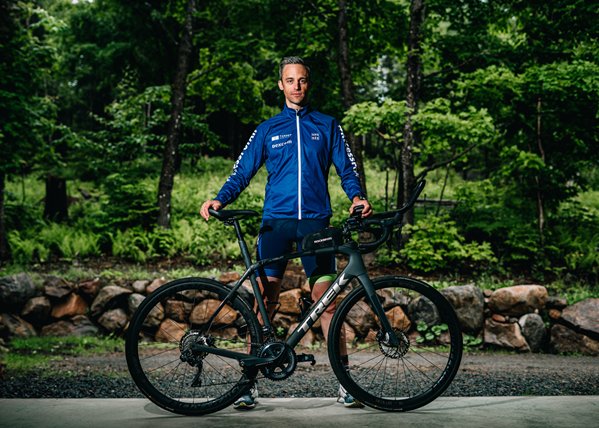Case Study: A Race Across Canada
In 2021, we witnessed the incredible feat of endurance athlete Sébastien Sasseville who rode across Canada in 15 days in support of Juvenile Diabetes Research Foundation (JDRF) Canada’s #AccessforAll Campaign. Sasseville’s ride covered about 6,000 km, and a total of 274 cycling hours.
Sasseville’s ride was the topic of a case study, written by renowned diabetes and exercise healthcare professionals, Lauren V. Turner, BSc and Michael C. Riddell, Ph.D. The study, entitled “Pushing the limits of insulin delivery 100 years later: A case study of a race across Canada”1 was published in Diabetes, Obesity and Metabolism.1

What Sasseville Taught Us About Exercise and T1D
Sasseville has been living with type 1 diabetes (T1D) since 2002 and uses the Tandem t:slim X2 insulin pump with Control-IQ technology, an advanced hybrid closed-loop system integrated with the Dexcom G6 Continuous Glucose Monitoring (CGM) System.* This advanced technology helped him ride without stopping to check and manage his insulin levels, ensuring he could meet his daily mileage goals.
The case study examined the value and effectiveness of an automated insulin delivery system (AID) for exercise over four time periods: pre-ride, in-ride, post-ride, and one month post-ride.
Before the ride, average 7-day glucose concentrations were significantly lower (8.6 ± 2.4 mmol/L) compared to in-ride (10.2 ± 3.9 mmol/L, P < .001). It was of interesting note that 7-day post-ride glycaemia remained elevated (10.4 ± 3.9 mmol/L, P < .001) but had dropped back down one month post-ride (9.0 ± 2.5 mmol/L, P < .001).
Sasseville’s median time in range (TIR) during 74 percent pre-ride, 64 percent while in-ride, 45 percent immediately post-ride, and 68 percent one month post-ride. The case study found no signs of symptomatic or significant hypoglycemia while in-ride, and measured CGM values only fell below 3.0 mmol/L on one day.
Insulin was delivered manually and through AID-informed boluses at a frequent rate, averaging 11.2 ± 4.7 and 6.6 ± 2.3 events per day respectively. The study notes that the amount of insulin delivered was typically small for both manual and automated boluses. During the pre-ride period, insulin was delivered through automated correction bolus at a rate of 4.14 ± 2.72 U/day. In-ride delivery sat at a rate of 1.57 ± 0.76 U/day, and post-ride was 2.19 ± 2.05 U/day. In the seven days post-ride, insulin delivery remained elevated at a rate of 7.05 ± 4.80 U/day.
The study importantly concluded that while using the AID system the athlete avoided time below range altogether, and there were no events in which glucagon was required to treat a hypoglycemic episode during the 16-day event.
While exercise has long been known to cause hypoglycemia in individuals with T1D, the introduction of CGM-integrated AID systems, modern insulin, and better clinical guidance has allowed numerous individuals, like Sasseville, to participate in and recover safely from extreme endurance events.
Click the link below to read the full case study.
* Products sold separately.
1 Turner LV, Riddell MC. Pushing the limits of insulin delivery 100 years later: A case study of a race across Canada. Diabetes Obes Metab. 2022 Jan;24 Suppl 1:58-62. doi: 10.1111/dom.14629. Epub 2022 Jan 4. PMID: 34957664.
LBL-1000226 Rev001
